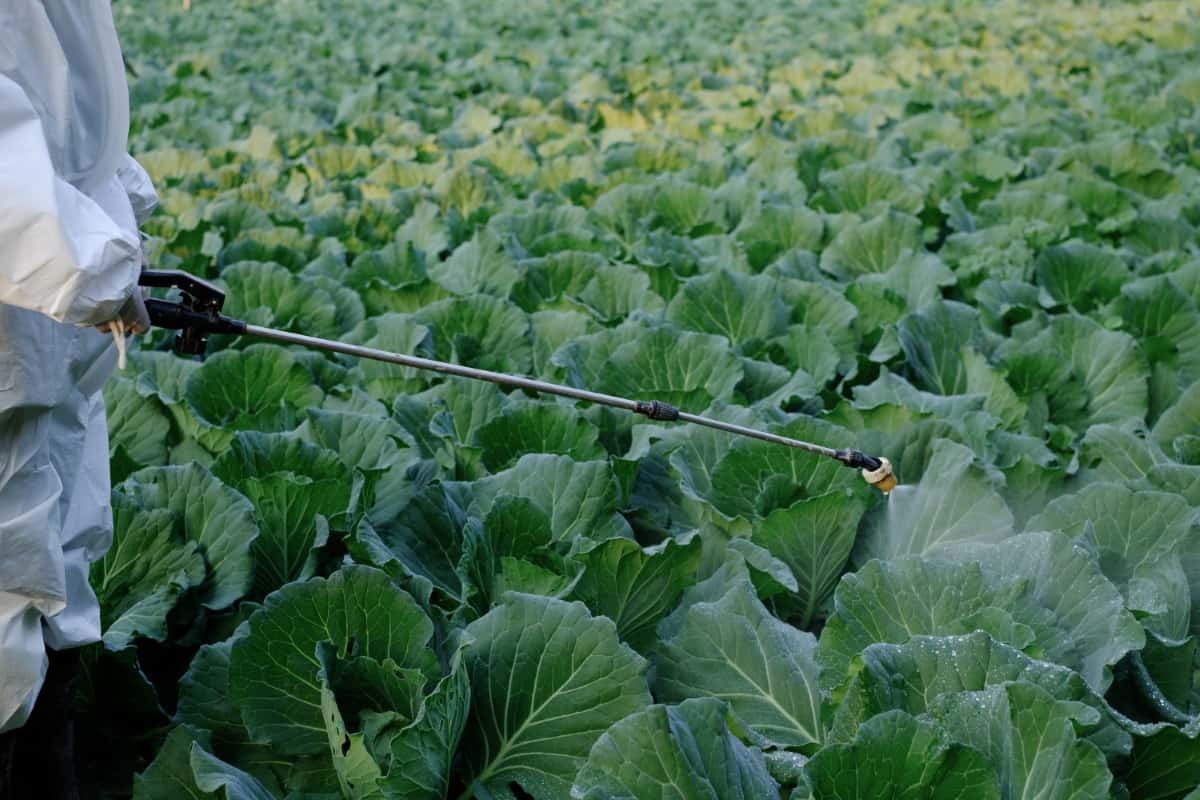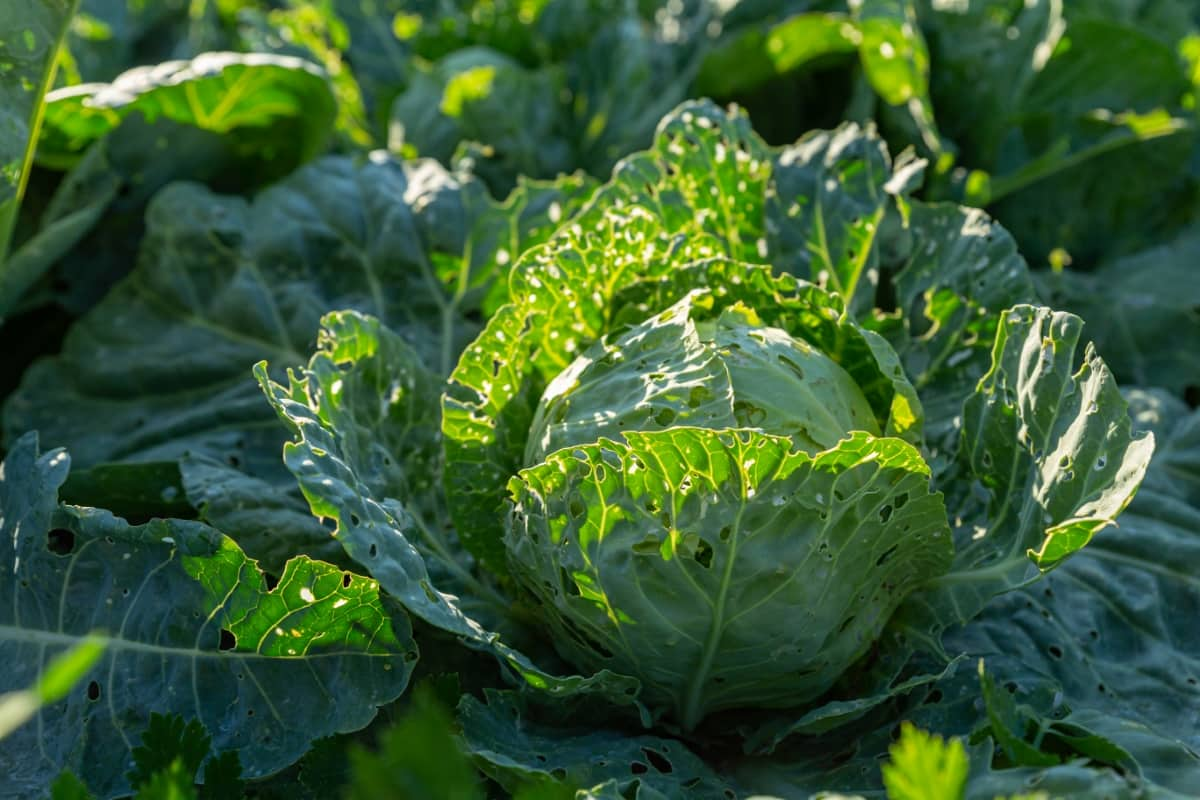Cabbage growers, brace yourselves! Your beloved cabbages are attacked by many pests that can munch on their leaves or drain their sap, leaving them weak and unfit for consumption. Fret not, for we have compiled a comprehensive list of these common cabbage-damaging culprits, complete with accurate identification details.

But fear not! In this blog post, we’ll dive into common cabbage-damaging pests, exploring their telltale symptoms and providing you with the best treatments to combat them. We’ll also share some handy prevention and management tips to keep these critters at bay.
Common Cabbage Damaging Pests
When it comes to cabbage pests, be prepared to face off against the infamous Cabbage Aphid and the troublesome Cabbage Root Maggot and Cabbage Worm. Stay vigilant for the cunning Cutworm, elusive Diamondback Moth, pesky Flea Beetle, voracious Grasshopper, crafty Harlequin Bug, slimy Slug, and sluggish Snail. These common pests can attack cabbage.
Control and Management of Aphid Pest Attack on Cabbage
Identification and Symptoms: Cabbage aphids, scientifically known as Brevicoryne brassicae, are a common pest on cabbage and related crops. These gray-green insects are often found in dense clusters, covered in a whitish-waxy coating, particularly on tender new growth.
While they can be present throughout spring and summer, their populations tend to increase in late summer and persist into autumn. The damage caused by cabbage aphids can be deceptive due to their camouflage. Look out for their feeding sites and the black deposits of honeydew they leave behind. Late-maturing Brussels sprouts and cabbage are particularly susceptible to their attack.
Prevention: Removing and composting old plants is important to prevent infestations, as cabbage aphids can overwinter in dead plant tissue. Trim and compost stem hosting aphid clusters. Regularly harvest Brussels sprouts to prevent them from becoming aphid nurseries. Encouraging beneficial insects like lady beetles, syrphid flies, and lacewings can help control aphid populations.
Management: During outbreaks, use a forceful water spray to remove aphids, then apply insecticidal soap twice, one week apart. Lady beetles, and their larvae are beneficial predators. Ant activity can signal aphid colonies due to honeydew attraction.
Control and Management of Cabbage Root Maggots Attack on Cabbage
Identification and Symptoms: Cabbage root maggots, also known as Cabbage Flies common pests, are tiny pests about the size of a grain of rice. Delicate, hump-backed grayish-brown flies lay small white bullet-shaped eggs on the main stem near the soil line. After hatching, the larvae tunnel into the roots, causing wilting and shriveling of the plants. These rice-sized white maggots can feed on the roots when affected plants are pulled up.
Prevention: To prevent problems, you can use floating row covers or vertical row cover “fences” on either side of the row to deter egg-laying adults. Creating cardboard, cloth, or heavy paper cabbage collars can protect individual seedlings. Mulching encourages ground beetles, which are natural predators of cabbage root maggots. Late summer is when these pests pose the most threat to fall crops like cabbage and cauliflower.
Management: Remove heavily affected plants and rinse their roots in warm water to dislodge the maggots. Alternatively, you can drown the maggots or feed them to chickens. Monitoring and trapping cabbage root flies can be done using yellow sticky traps or pans of water.
Control and Management of Cabbage Worms Attack on Cabbage
Identification and Symptoms: Cabbage worms common pests, including the imported cabbageworm (Pieris rapae) and cabbage loopers (Trichoplusia ni), are common pests that damage cabbage family crops. The imported cabbageworm larvae are velvety green with faint yellow stripes, while cabbage loopers are Caterpillars that move by raising and lowering their backs. Adult moths of these species lay eggs on the undersides of leaves, and the caterpillars immediately begin feeding, leaving behind frass or excrement. Late in the season, they can hide inside the bases of cabbage or cauliflower heads.
In case you missed it: Common Citrus Tree Diseases: Symptoms, Treatment, Control, Prevention, and Management

Prevention and Management: To prevent problems, use row covers and plant nectar-rich flowers and herbs to attract beneficial insects. Regularly check plants for frass and use effective pesticides like B.t. (Bacillus thuringiensis). Planting red-leafed varieties can also deter cabbage worms.
Control and Management of Cutworms Pest Attack on Cabbage
Identification and Symptoms: Cutworms, including the black Cutworm (Agrotis ipsilon) and variegated Cutworm (Peridroma sauce), are common pests in vegetable gardens. These caterpillars hide in the earth and feed on plants at night. Variegated cutworms are mottled brown with a thin white line along their backs, while black cutworms feature little black spots. The larvae of cutworms feed on the roots and foliage of young plants, often cutting them at the soil line, causing the top portion of the plant to wither and die. In summer, they can also climb plants and chew holes in the foliage, resembling slug damage.
Prevention: To prevent cutworm problems, use cutworm collars made of cardboard, metal cans, or plastic drink cups placed around vulnerable plants. Bt (Bacillus thuringiensis), a biological pesticide, can be mixed with oatmeal or cornmeal and scattered on the soil’s surface to attract and kill foraging cutworms. Providing perches for insect-eating birds and frequent shallow cultivation can also help manage outbreaks.
Management: Bt solution can be used as a management tool. Trapping adult moths can be done passively by placing solar landscape lights above pails of soapy water. Be vigilant when growing vegetables in new beds previously covered with grass and weeds.
Control and Management of Diamondback Moth Attack on Cabbage
Identification and Symptoms: Diamondback moths (Plutella xylostella), or cabbage moths, are common pests primarily targeting cabbage family crops. Adult diamondback moths themselves do not cause any damage. They lay their eggs on cabbage plants, and the hatched tiny green caterpillars with forked tails begin feeding on the leaves. Unlike cabbage worms, they have a different appearance, with whitish heads and feet. The caterpillars rasp holes in the leaves, giving them a windowpane-like appearance.
Prevention: To prevent problems, you can create a sacrificial planting of cress in spring to divert the moths and their eggs away from your garden plants. Protective row covers can exclude diamondback moths and other pests from cabbage family crops.
Management: Managing outbreaks can be challenging as diamondback moths have developed resistance to many pesticides, including Bt. Handpicking the caterpillars is a more effective option, especially when done daily. Beneficial insects like wasps and hornets can also help control the larvae by feeding them to their young. During the summer, diamondback moths can complete their life cycle within 15-30 days. It’s advisable to avoid planting successive brassica crops if a diamondback moth infestation has occurred.
Control and Management of Flea Beetles Attack on Cabbage
Identification and Symptoms: Flea beetles belonging to Phyllotreta, Psylliodes, and Epitrix species are small dark brown to black beetles, approximately 2-3mm (about 1/10in) long. They can be found on leaves and quickly jump away when disturbed. These beetles chew tiny round holes in the top sides of leaves, causing most severe damage in spring and during the warm summer months for eggplant and tomato crops.
Prevention and Management: To prevent problems, rotate crops and use row covers (garden fleece) to protect susceptible plants. Plant mustard along the garden edge as a trap crop to divert flea beetles away from main crops. White sticky traps can capture flea beetles, and spinosad, a biological pesticide, can be applied, although populations may rebound quickly.
Control and Management of Harlequin Bugs Attack on Cabbage
Harlequin bugs, scientifically known as Murgantia histrionica or Calico Bugs, are brightly marked black-and-orange shield bugs commonly found on cabbage family crops in North America. They suck plant juices, causing feeding wounds and moisture loss. Young harlequin bugs are black and yellow.
To prevent problems, use cleome flowers as trap crops and scout for and destroy their barrel-shaped eggs. Handpicking and using spinosad (a biological pesticide) can help manage severe infestations. In warm climates, harvesting early brassicas promptly and using row covers for seedlings in summer are recommended.
Control and Management of Slugs and Snails on Cabbage
Slugs and snails are common garden pests, especially in cool and moist climates. They feed on many plants, including beans, lettuce, cabbage, and tomatoes. Slugs and snails leave a trail of slime behind them as they move. They can cause damage by chewing holes in leaves, fruits, and small seedlings. Prevention measures include:
- Handpicking.
- Drowning them in soapy water.
- Reducing their habitat by delaying mulching.
Natural predators such as frogs, toads, snakes, turtles, and birds can help control them. Iron phosphate slug baits are considered acceptable for managing outbreaks.
In case you missed it: Common Banana Diseases: Symptoms, Spread, Identification, Treatment, Control, and Management

Conclusion
Common cabbage-damaging pests include diamondback moths, flea beetles, harlequin bugs, and slugs/snails. Symptoms include leaf damage and holes. The best treatment involves handpicking, using biological pesticides, and employing preventive measures like row covers and trap crops. Natural predators can also help manage outbreaks.
- Types of Fungicides Used in Agriculture
- Common Issues in the Fruit Development Stage of Pomegranate Farming
- Fruit Development Issues in Papaya: Easy Solutions and Treatment
- Soil-Borne Diseases and How to Protect Your Plants
- Practices to Prevent Disease Spread in the Garden
- From Wilted to Thriving: How to Treat Root Rot Naturally in Houseplants
- Natural Remedies to Cure Brown Spots on Fig Tree Leaves
- Natural Solutions for Poinsettia Problems: 100% Effective Remedies
- How to Control Calla Lily Problems: Natural Remedies for Leaf and Flower Problems